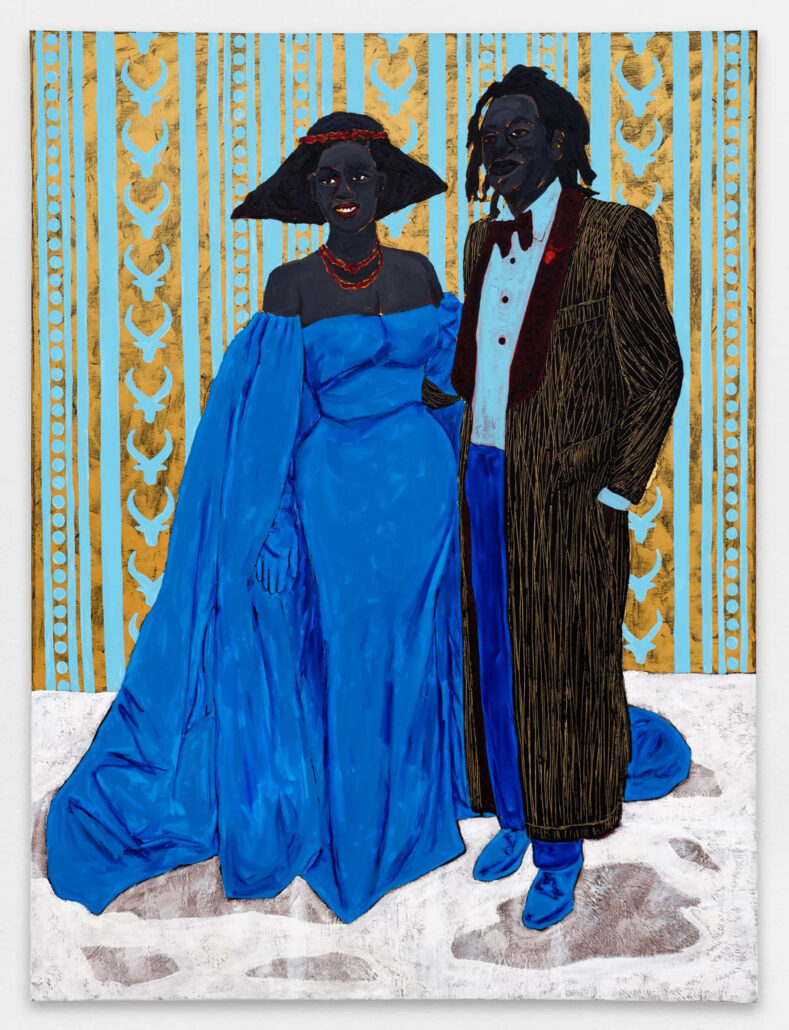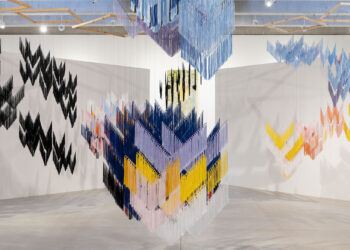Galerie Nathalie Obadia announces ‘WE COME IN PEACE’, Collin Sekajugo’s first solo exhibition in France, which follows on from ‘Radiance, They Dream in Time’, presented at the 59th Venice Biennale in 2022.

Collin Sekajugo, Stock Image 30 – Blue Evening, 2022. Acrylic and barkcloth on canvas, 160 x 120 x 4cm. Courtesy of the artist and Galerie Nathalie Obadia.
The first ever Ugandan pavilion, exhibiting works by Sekajugo alongside the artist Acaye Kerunen, received a special mention among the national entries and was acclaimed by the international press for its particular relevance.
Born in 1980 in Masaka (Uganda), Collin Sekajugo is particularly interested in the question of the human condition in the age of globalisation. At the dawn of the third millennium, the establishment of digital technology in our daily activities has radically changed our relationship to the world and to information, which now, completely emancipated from its material form, has acquired the power to homogenise collective thought with a simple click.
The exhibition ‘WE COME IN PEACE’ explores the numerous prejudices that have proliferated across the globe. This new body of work, created using an extremely diverse combination of materials and techniques, presents the artist’s latest series of portraits of ambiguous figures from, amongst others, the countries of Asia, the Indian Ocean and the Commonwealth, all of whom are recognised figures of power and influence.
At the heart of this new exhibition, Collin Sekajugo focuses on the complex and sometimes conflictual question of cultural identity. By manipulating archival images, the artist explores the particular characteristics of each subject, questioning her or his place in our contemporary society. At first glance the importance of these influential personalities seems assured and unassailable; alone or in pairs and elegantly outfitted, the figures stand out from backgrounds decorated with African motifs. Certain details however, have a destabilising effect of the viewer’s perception. Although the African heritage of the sixteen portraits from the Blacks of East series is suggested by their physical features, these figures are in fact from the socio-economic world of Asia and the Indian Ocean. In this way, Collin Sekajugo illustrates the cultural métissage the world has undergone in the age of globalisation, a contemporary particularity that he underlines by his use of a specific chromatic combination for the skin of his subjects, bringing together darker and lighter tones.
Other portraits, deployed across the gallery space, present well-known, globally influential figures, whose identities have been consciously appropriated by the artist. Lady Gaga, Elon Musk and Jeff Bezos amongst others, cloaked in their finery, are given a complete make-over in the exhibition. Thus, a new and different version of the usual images of figures of power is revealed, lifting the veil on the privileges and entitlements governed by the white sphere of influence.
Through these portraits, Sekajugo achieves an anthropological inversion of the dominant culture: he highlights the ambiguity of cultural identity and pays homage to the heritage of East Africa by adorning his backgrounds with African motifs. These motifs, although a centuries-old part of Ugandan culture, have been sparsely documented and even ignored in the global artistic debate.
Collin Sekajugo lends particular importance to the social fabric and identity of his native country, an interest that he extends across the entire globe. Beyond the symbols and messages conveyed by the subjects he presents, the artist’s works are like meeting spaces: on one hand the spectator is confronted with a new subject, and on the other his or her eye is attracted by a diversity of techniques and materials within a single painting. The artist concocts his works from multiple materials, most of which are Ugandan in origin: polypropylene bags, bark cloth, wax cloth and denim. The latter is used to make jeans, an everyday item of clothing, reflecting the phenomenon of globalisation, worn throughout Africa as well as the rest of the world. Wax cloth is historically connected to the colonisation of Indonesia by the Dutch in the 17th and 18th centuries, from where it was exported to the West coast of Africa. These colourful fabrics are now widely used by local tailors to make elegant clothes. By combining these different materials, the artist has created his own visual language, highlighting the continent’s history and know-how, while pushing back the boundaries of traditional artistic creativity.
These new compositions are imbued with personal narratives and strong universal messages, forging links with the Ugandan population as well as all other spectators as they identify the subjects portrayed. This ability to connect with his audience stems from Collin Sekajugo’s deep social commitment, in particular to the communities of his native country. From the early days of his career, he has used his artistic practice as a lever for social rehabilitation through the creation of a collaborative space dedicated to the visual arts in Kigali, Rwanda, that he has named Ivuka (rebirth in the local language). Building on his success, Collin Sekajugo exported this model to Masaka in Uganda in 2010, where it has become the nerve centre of the city’s artistic and cultural life.
In dealing with the globalisation of cultural dominance and the influence of capitalism in our daily lives, the exhibition ‘WE COME IN PEACE’ allows us to shed new light on the notion of living in community in the 21st century, no matter where we are from and whatever our parentage.
The exhibition will be on view from the 20th of January until the 4th of March 2023. For more information, please visit Galerie Nathalie Obadia.



